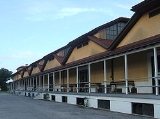
Archbold Biological Station
Encyclopedia
The Archbold Biological Station (ABS) is a research institute with a surrounding 5192.63 acres (21 km²) estate near Lake Placid, Florida
, USA
. It includes an extensive area of Florida scrub
, a scientifically interesting and highly threatened ecosystem
. It was established in 1941 by Richard Archbold
when his sponsorship of zoological research in New Guinea
was curtailed by the outbreak of the Second World War
in the Pacific region. The Station supports 19 federally listed threatened species, including the Sand Skink (Neoseps reynoldsi
) and 13 endemic plant species. It is a venue for field research and education.
On July 20, 2007, it was added to the U.S. National Register of Historic Places
.
Archbold acquired the initial land for the biological research station through his friend Donald Roebling
from the Roebling family. Subsequently, additional land was purchased.
Lake Placid, Florida
Lake Placid is a town in Highlands County, Florida, United States. The U.S. Census Bureau estimated the town's population as 1,878 on 1 July 2007...
, USA
United States
The United States of America is a federal constitutional republic comprising fifty states and a federal district...
. It includes an extensive area of Florida scrub
Florida scrub
Florida scrub is an endangered temperate coniferous forest ecoregion of the state of Florida in the United States. It is found on coastal and inland sand ridges and is characterized by a xeromorphic plant community dominated by shrubs and dwarf oaks. Scrub soils, a type of entisol, are derived...
, a scientifically interesting and highly threatened ecosystem
Ecosystem
An ecosystem is a biological environment consisting of all the organisms living in a particular area, as well as all the nonliving , physical components of the environment with which the organisms interact, such as air, soil, water and sunlight....
. It was established in 1941 by Richard Archbold
Richard Archbold
Richard Archbold was an American zoologist and philanthropist. He was independently wealthy, being the grandson of the capitalist John Dustin Archbold. He was educated at private schools and later attended classes at Columbia University though he never graduated...
when his sponsorship of zoological research in New Guinea
New Guinea
New Guinea is the world's second largest island, after Greenland, covering a land area of 786,000 km2. Located in the southwest Pacific Ocean, it lies geographically to the east of the Malay Archipelago, with which it is sometimes included as part of a greater Indo-Australian Archipelago...
was curtailed by the outbreak of the Second World War
World War II
World War II, or the Second World War , was a global conflict lasting from 1939 to 1945, involving most of the world's nations—including all of the great powers—eventually forming two opposing military alliances: the Allies and the Axis...
in the Pacific region. The Station supports 19 federally listed threatened species, including the Sand Skink (Neoseps reynoldsi
Neoseps
There is only one species known of the genus Neoseps, the Neoseps reynoldsi, commonly known as the Florida sand skink. The species has been described by Leonhard Hess Stejneger in 1910 and named in honor of one A. G...
) and 13 endemic plant species. It is a venue for field research and education.
On July 20, 2007, it was added to the U.S. National Register of Historic Places
National Register of Historic Places
The National Register of Historic Places is the United States government's official list of districts, sites, buildings, structures, and objects deemed worthy of preservation...
.
Archbold acquired the initial land for the biological research station through his friend Donald Roebling
Donald Roebling
Donald Roebling was an eccentric twentieth century American philanthropist and inventor. He is most famous for inventing the amtrac in 1937, which he originally intended to be a hurricane rescue device...
from the Roebling family. Subsequently, additional land was purchased.

